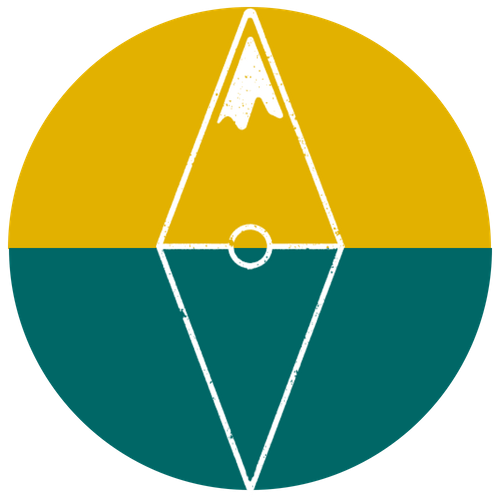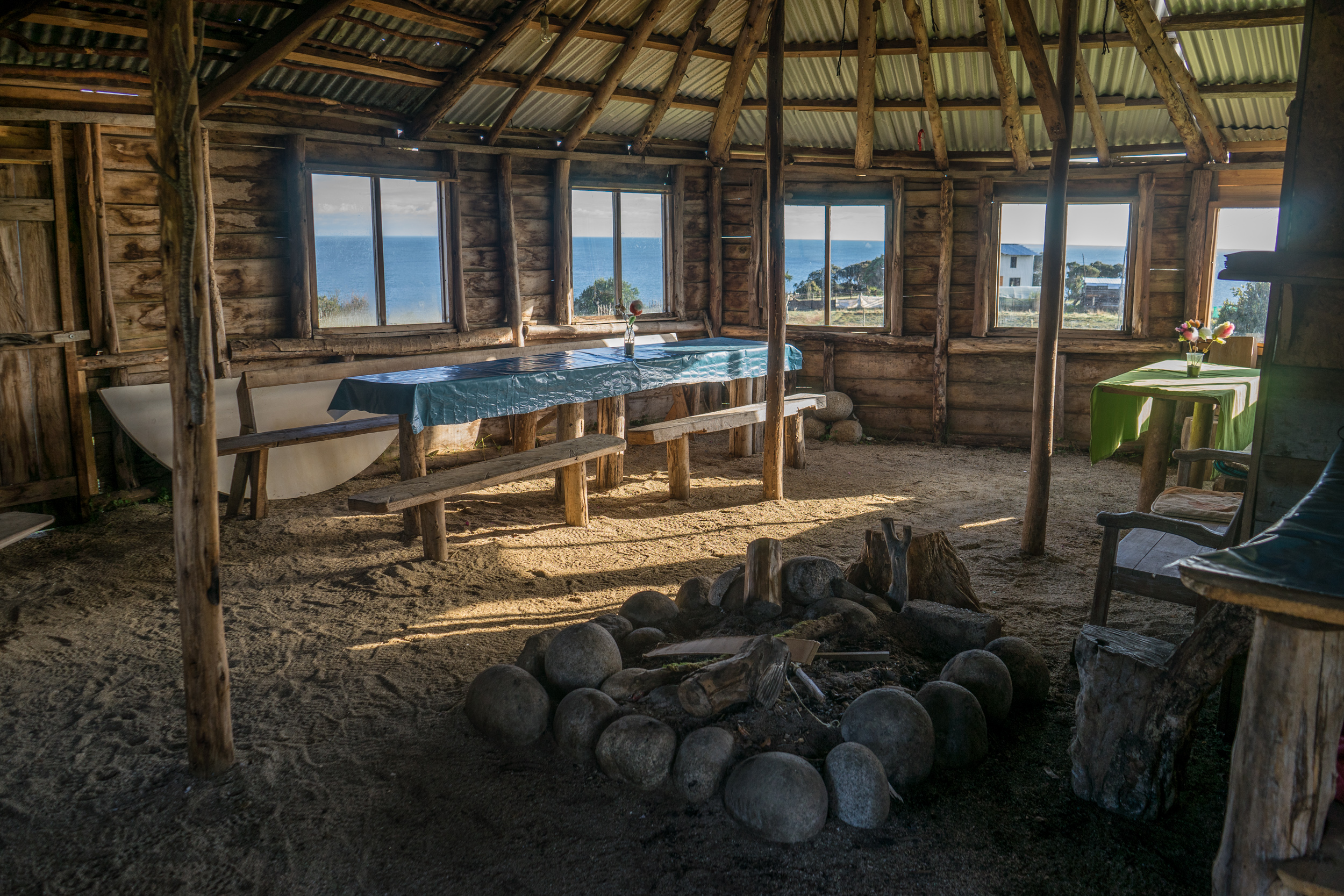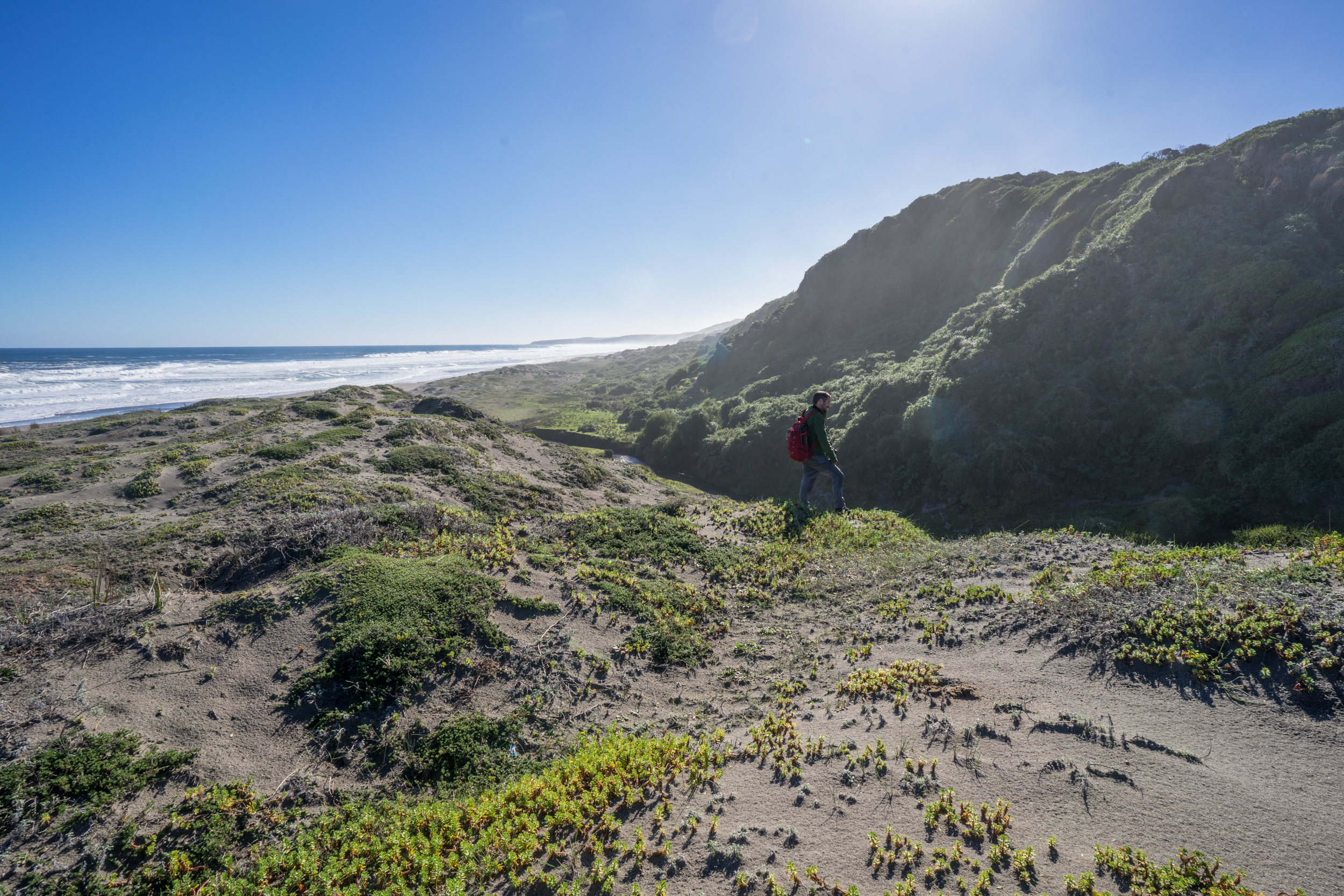WHERE THE OCEAN AND THE FOREST MEET: The Valdivian Coastal Reserve
Text & Photos: Andreea Lotak · 12 min read
Valdivian Coastal Reserve dunes, Chile
The strong afternoon sun was coating the sand in a metallic glow. After a two-hour hike on a muddy trail where we could witness the destruction of the native forest, we had finally arrived to one of the most beautiful, eerie places we had seen in Chile: the giant sand dunes of Colún that reach toward the ocean on one side and to the evergreen, centuries-old forest on the other. Swept by winds from the ocean, the sand was slowly embracing the forest in its inland advance. Braving the mud in which our boots were caked was definitely worth this amazing sight.
The Valdivian Coastal Reserve is 50,000 ha (123,500 acres) of protected coast and native forest. Within it, a patch of about 3,500 ha of exotic eucalyptus plantations bear witness to the destiny that was awaiting these ecosystems whose peace and resilience now seem unchallenged. In 2003 this massive piece of land was acquired by The Nature Conservancy and with this a new path was forged. Before it had belonged to a forestry operation, Bosque S.A., who had received approvals to fell the ancient evergreen trees and replace them with eucalyptus whose profitable wood is used by the cellulose, construction and furniture industries. However, the operation didn’t succeed; the company went bankrupt and the land went up for sale. In parallel, works for the construction of a coastal highway through these same forests had already started. However, under The Nature Conservancy’s stewardship a new story started to be written and the Valdivian Coastal Reserve was created.
“Now we are in the reforestation process, working to reconvert those plantations to the native forest”, told us Liliana Pezoa, administrator of the reserve, while in the organization’s main office in the city of Valdivia. The morning before we headed to the reserve she agreed to meet us and walk us through some of the details that go into managing such a large conservation project. “In 2003 The Nature Conservancy (TNC) acquired 60,000 ha of land. A 10,000 ha portion of it was donated to the Chilean state to create the Coastal Alerce National Park in 2012”. In the process TNC also negotiated the addition of another 5,000 ha of state-owned land used by the military for practice to this newly created national park. As Liliana put it: “To us this donation didn’t mean that we lost 10,000 ha from our land, but instead that we succeeded in adding another 5,000 ha to the territory, which weren’t protected before”. Together with the national park the organization is working on various levels, including in the management of forest fires which are a major threat to the ecosystem. Then Liliana went into explaining a bit about the importance of this forests and coast.
The Valdivian temperate forest is an ecoregion of high importance at an international level, a true remnant of the times when the dinosaurs had just disappeared from the Earth. Developing in isolation, these rich forests have extremely high rates of endemic species of flora and fauna inhabiting them and can only be found in southern South America. Of the impressive evergreen trees found here, the alerce (Fitzroya cupressoides) stands out. These ancient trees similar to the giant sequoias have been around for over 3,000 years. “There are isolated parts of the reserve that we haven’t even reached or explored yet, we don’t know what’s there”, added Liliana with a smile of excitement. From the day hikes and explorations we did, an image comes to mind now while writing this story: reaching a vantage point from where a patch of old-growth forest stretched to the horizon, endless and impenetrable. Liliana showed us during the interview some drone images of where the construction of the highway stopped when TNC changed the direction where the land was heading. It’s hard to capture in words the feeling it gives: there are tree stumps along this unfinished road. But then, right pass the line where the machines stopped working, a green wall starts. That first line of trees hundreds of years old that were steps away from being cut down are now towering over the clearing made by the abandoned work construction. The next picture in the slideshow was of an area where the native forest has returned on its own, winning the competition with the eucalyptus trees that were eventually removed.
After this rather reflective moment, the conversation turned more technical, as Liliana gave us a summary of the work that goes into managing the reserve. “How do we work with such a large reserve? Where do we start? Do we just put a fence around it and call it a conservation area? That’s one way. But really what we try to do is protect this area for the next generations and for the present ones. Therefore we have to generate a plan for a sustainable, responsible use of resources. We can’t just close the territory to the people living around or within it. How do we make this work with conservation?”. One of the answers is the employment of the so-called “Open Standards” methodology, a new strategy created and commonly used by all the large international conservation organizations. The way that Liliana described it to us made it sound like a sort of step-by-step “How to” guide for managing a conservation area.
“We have a Management Plan, a Monitoring Plan and an Area Conservation Plan. The Management Plan tells us what to do day-by-day, all the administrative chores, from rangers’ uniforms to management of economic activities like forestry and livestock. TNC doesn’t have livestock, obviously, but the communities within and around the reserve do, and we have to reach agreements with them on how to handle it sustainably. Then we have a public use program. In Chile, by law the access to lakes, beaches and rivers cannot be restricted, so we have to designate areas of public use in a responsible way through evaluating the land’s capacity for visitation and other factors. We have trails within the reserve, but we don’t charge entrance fees. We do work with local guides whom we’ve trained and they are the ones who receive payments directly for the services lent to visitors. It’s a way to give back to the community, but also to manage the trails in a less impactful way. There is also a program of community involvement and local economic development with the function of turning the locals into stakeholders of this conservation area.”
One of the short hikes, the Colmillos (fangs) of Chaihuín, nearby the Valdivian Costal Reserve offices. It's a walk through the olivillo tree forest down to the beach where two rock formations are known as the "fangs of Chaihuín"
Management of coastal resources is one of the main focuses of The Nature Conservancy within and outside the reserve, working together with communities and local NGOs
The visit to the Valdivian Coastal Reserve was to us a mix of nature and local culture. The indigenous Mapuche - Huilliche fishing communities continue their way of life within the villages scattered across the coast, while in the caves hidden by the beach dunes there are artifacts and primitive paintings of indigenous groups from 7,000 years ago. We spent two nights in our tent set inside a hut on the land of a Huilliche old lady and her family, in the Huiro village bordering the reserve. Her son worked as a ranger in the TNC reserve, as we found out later. She was kind and beautiful and reminded me of my grandmother - a sort of inner peace and an honest, uncomplicated love for the land she inhabited. Out of all the places we’ve left behind so far in this trip, this one somehow was the hardest for me to leave. At sunset and sunrise the rugged coast to which this piece of land offered access was beyond description. A colony of sea lions, likely males that had lost leadership of their harems, took refuge on some of the rocks swept by massive waves within sight and we could hear their loud calls throughout the night from our tent uphill.
Inside the hut where we pitched our tent
The coast from the land of our host in Huiro
One of the directives of TNC within the reserve was to create a sustainable management plan of coastal and ocean resources. In collaboration with other local NGOs, they also encourage the valorization of traditional food and ingredients of the people living in the villages as products for export to other regions of Chile. Overall the commitment of TNC’s conservation work revolves around protecting and recovering the native flora and fauna, while at the same time generating a sustainable economy for the people sharing this space. Liliana gave us a short insight into their methods for setting goals and the strategies to achieve these goals: “In the 50,000 ha, we started by identifying which are the key species and ecosystems that cannot be altered. We have the temperate rainforest, the amphibians like the Darwin’s frog, the bodies of fresh water. One by one we analyzed the species and ecosystems that are highly relevant to the ecological wellbeing of the reserve. Afterwards we looked at the threats, then created the strategies to control them. It’s how we developed the Area Conservation Plan. This is a sum up of a sum up, obviously [laughs]. To get to these simplified processes there is a huge work done initially following standards and methodologies. To mitigate those threats identified is where a lot of efforts go. It’s often easier to reduce indirect threats, while the direct ones are very complex. In some cases they entail changing ancestral habits of the community. It’s not enough to just tell people to do or not do something. You have to bring alternatives, invest in environmental education, and in raising awareness. We consider the results we want and define the activities that can be done within the reserve to help achieve them. These activities go into creating the Management Plan, of which tourism is an integral part.”
Liliana tells us that more visitors are arriving each year and that TNC is working with the local authorities to accommodate these increasing numbers and to limit their impacts. “For visitors we have regulated the access to certain trails to happen only in the company of local guides. The guides can manage the numbers of people per day that can enter on the trail, reducing the impacts. As far as the access to other areas in the reserve, the dirt roads are in poor conditions and require mostly 4x4 vehicles. We therefore request that people register with us at the entrance in the reserve and let us know of their plans so that we can appreciate if something goes wrong and assistance might be needed.” We went to the area with a small car. It limited our access to the heart of the reserve or to its southern boundary, but the three days spent getting to know the northern sections and the impressive dunes of Colún abounded in rewards.
The beginning of our hike to the dunes
Native Valdivian temperate forests
Reaching the dunes in Colún brought us to the place where the evergreen forests that have survived the destruction meet the ocean.
Almost at the top of one of the dunes. On the other side, the sand is slowly advancing into the evergreen forest.
Finally, before we headed out, Liliana told us that she has one more thing to show us: the picture of a young Darwin’s fox caught by the camera traps in the reserve. The appearance of this species in the territory of the Alerce Costero National Park and the Valdivian Coastal Reserve, as well as in another private conservation park nearby was a major change of paradigm. Scientists had previously considered that the territory of this fox was limited only to the Island of Chiloé and the Nahuelbuta National Park. In 2014 it was officially accepted that the Valdivian Coastal Reserve and the surroundings were part of its habitat range. The image of the young fox was a great sign, according to Liliana, because it meant that the population is reproducing and growing. The reserve’s management and conservation plans had to be changed to include the protection of the species as one of the major focuses.
The Valdivian Coastal Reserve was the last conservation destination on our itinerary in Chile. South of there stretched the wildness of Patagonia; north, the urban sprawls of Santiago’s metropolitan area where we would soon head. During our last evening in the reserve we walked to the coast downhill from where our tent was pitched and sat there watching the sea lion colony in the sunset light. During the day we had hiked to the sand dunes of Colún through a portion of the eucalyptus plantation left behind by the forestry company whose vision for this land was a very different one. The exotic trees rise high and have a beauty of their own, but the soil beneath is already eroding and turning into an undrained muddy mess. Beyond the eucalyptus trees the century-old native forests remain. The local communities are adapting to the new opportunities, and those who would have worked to cut down the trees now work to protect them. A better life is something that we all seek and economic opportunities come in different ways. We thought that we were happy that the the kind of opportunities now present in this territory allowed for the beauty and health of the land to continue unhindered. Meanwhile, the sky and ocean turned a velvet color and the dusk’s light faded. It was time to head uphill and prepare our last camping dinner in Chile, while hearing in the background the loud calls of the sea lions.
One of the sea lion colonies at sunset



















On a land destined to be logged, some of the most pristine valdivian temperate forests are now protected by this Nature Conservancy reserve. With its rugged coasts, ancient trees, impressive sand dunes, and local culture, it is a beautiful place to explore. Interview with Liliana Pezoa, administrator of the reserve.